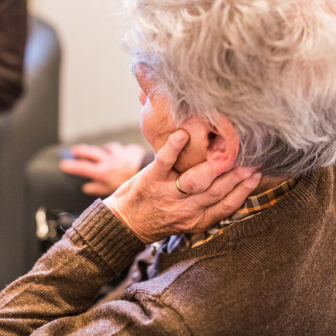Recent media reports of appalling conditions in some aged-care facilities led to yet another independent inquiry, the Carnell review, which found that little had changed since the kerosene baths scandal of 2000. Yet the federal government has so far pledged to act on just one of Carnell’s ten recommendations. Meanwhile, important proposals from previous reviews have gone unimplemented.
Australia has around 2700 accredited residential aged-care facilities. Together, in 2015–16, they provided care to 234,931 permanent residents, the majority of whom required high levels of care. Although most older Australians prefer to receive services in their own homes, a whole range of factors — including longer lives, dementia, and the inability of working families to provide care — mean that increasing numbers will eventually move into residential care.
Naturally, that likelihood increases with age. The average age of entry to permanent residential care in 2015–16 was 82.0 years for men and 84.5 years for women (up from 79.5 years and 82.8 years respectively twenty years earlier). Eighty-three per cent of these new residents needed high-level care, compared to less than 60 per cent in 1997–98, mainly because of rising rates of dementia.
For men, the risk of entry to permanent residential care is associated mainly with disease; for women, social vulnerability and functional capacities are more predictive. People in residential care have an average of eight health conditions, of which heart disease, stroke, arthritis, mental health and behavioural disorders, and dementia are the most common. Often, a long stay in hospital signals the transition from home-based care to a nursing home. Most residents (91 per cent) will die there, 40 per cent of them within the first nine months, but the average length of stay is 2.1 years for males and 3.2 years for females.
Those are the numbers today, but the future looks even more challenging. Australian baby boomers number around 5.5 million, and by 2050 the youngest of them — more than one million people — will be aged eighty-five and over. They are overseeing the care of their elderly parents, even as they begin planning for their own long-term care. Many of them have glimpsed a possible future, and it’s not one they want for themselves. This is the generation that can spearhead a campaign for better care.
We can be fairly certain about how numerous older Australians will be in the future, but we’re much less certain about the proportion who will need care and the type of care that will involve. But those estimates are essential for planning, especially given the long lead times involved for residential care.
Here’s how the system works at present. The government sets a capped target for aged-care places, both community and residential, based on the number of people aged seventy and over. The target ratio is set to increase from 113 operational places per 1000 people in 2012 to 125 by 2021–22, but this increase will all be in home-care places. The ratio for residential care is currently set at 86 (but is only 79.9) and will decrease to 78 in 2021–22.
It’s assumed that a higher proportion of baby boomers will want home care, but the big unknown is the gap between what people want and what they will need. Achieving the target ratios by 2021–22 will require an additional 49,000 residential places. According to one estimate, $33 billion will be needed over the next ten years to build new facilities and refurbish existing ones. The current shortage of nursing home places, already quite severe in some areas, could easily get much worse.
The biggest obstacle to equitable access to residential places is the accelerating shift from religious, community-based and charitable organisations to for-profit providers. The aged-care sector is continuing to consolidate, with the number of residential places increasing while the number of providers falls. In 2016, for-profit providers — a shade over a third of the industry — were awarded 63 per cent of the 10,940 new places, including nine of the ten largest allocations.
Of the residential-care sector’s $17.4 billion in revenue in 2015–16, $11.4 billion came from the federal government and around $4.5 billion (excluding accommodation deposits) from residents. The average annual profit margin has been calculated at $11,134 per resident; given that this includes data from both the non-profit and for-profit sectors, it’s clear some providers are making substantial profits. One study shows that the most profitable quarter of providers are making 2.5 times as much as the average provider, while others, especially in rural and more remote areas, are struggling.
This increasing reliance on a mainly government-funded private sector is a recognised recipe for disaster unless there is strong, independent oversight of performance against agreed standards. And so it has proved. The consequences are far worse than the equity problems created when new facilities are concentrated in well-to-do metropolitan areas. The push to generate profits affects workforce numbers and qualifications and leads to rationing and neglect and gaming the accreditation system, and the results can be life-threatening for residents.
Workforce numbers are the vital factor. Quality and safety, protection of rights and dignity, respect for culture and lifestyle — all these rely on adequate numbers of well-trained staff, especially for those residents who have no one else to watch over them.
An estimated 235,764 people were working in residential care in 2016. The majority were personal care assistants, with nurses (both registered and enrolled) making up a small and declining minority. Some 1701 fewer full-time equivalent RNs worked in aged care in 2016 than in 2003, a period in which the number of residential aged-care places increased by 30 per cent. Acknowledged skills shortages are one factor, aggravated by low wages, but in too many cases the number of trained nurses is kept low as a cost-saving measure. The use of casual staff to fill workforce gaps only exacerbates sustainability, thus creating a vicious cycle.
A recent survey of the aged-care workforce found that people are worried about staffing levels at their workplace and want more time to care for residents. The analysis showed that residents should be receiving an average of four hours and eighteen minutes of care each day, but currently only two hours and fifty minutes is being provided. In many situations, a single registered nurse is responsible for over one hundred patients; administration and paperwork requirements mean that most nurses are spending less than a third of their time on care.
The consequences can be severe: falls, urinary tract infections, malnutrition, pressure sores, assault by other residents. Partly as a result, preventable deaths in residential aged care have risen 400 per cent over the past decade, mostly as a result of falls, choking and suicide.
It’s predicted that the aged-care workforce will need to grow by about 2 per cent annually for the next thirty years to meet demand, even with technological innovation and changes to service-delivery models. Staff will need to be trained to provide complex care to people from culturally and linguistically diverse backgrounds and from the LGBTI communities.
Although the government recently established a taskforce to develop an aged-care workforce strategy, it has done nothing to tackle the deficiencies in data and lack of nationally agreed standards that make it difficult not only to analyse the current workforce and also to assess future needs. Operators have found it far too easy to satisfy accreditation audits, announced months in advance, which focus on compliance with paperwork and rarely follow up concerns raised. Failures of care are mostly brought to light by family members, and adverse media coverage also generally originates with families. Earlier this year, abuse and neglect was revealed at a South Australian nursing home that had easily passed accreditation audits despite a decade-long history of poor care. Aged care minister Ken Wyatt has at last announced that providers will now be subject, without warning, to comprehensive inspections over several days.
Much more needs to be done. The current standards — which require nursing homes to provide “adequate nourishment and hydration,” for instance, and “maintain an adequate number of appropriately skilled staff” — are so general as to be almost useless. No federal standards exist for nutrition and menu planning or for staff-to-resident ratios and skill prerequisites. Infection control practices are patchy and guidelines about the use of physical and pharmacological restraints are ignored. In too many cases, family members who speak out about residents’ care and conditions are banned from visiting. Small wonder that conditions at one nursing home were likened to Guantanamo Bay.
The government’s 2015 Aged Care Roadmap aimed to move aged care towards a market-based, demand-driven system, with proposals to uncap places, open up pricing, reduce regulations and get rid of red tape. But even the chair of the committee that produced the report says these are radical changes and cautions that the risks to providers, consumers and government of such changes would need to be carefully managed.
Australian government spending on aged care will more than double relative to national income between 2010 and 2050. Long-term solutions that are financially viable for both government and users of the system will not be delivered simply by new business models in the private sector. Aged care is much more than “an industry” within the Australian economy, it’s about providing respect, dignity, comfort and care to elderly Australians at the end of their lives. ●




